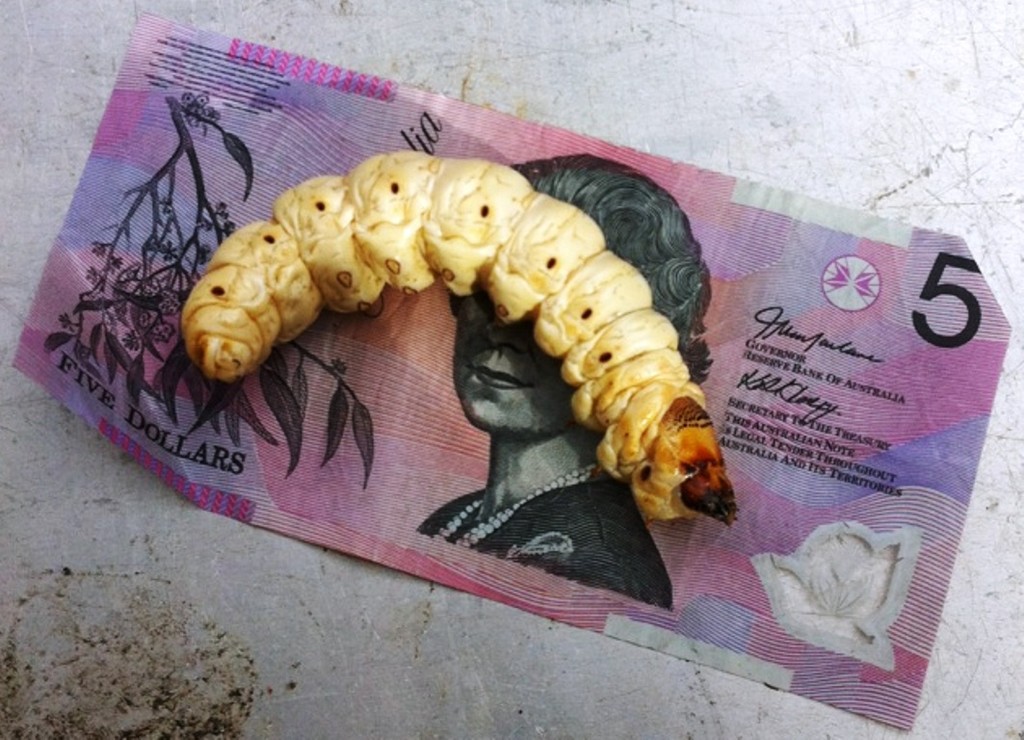Do you know grubs?
by Carl Hyland on 31 Jul 2012

This is a big grub. Carl Hyland
Did you know, the Tasmanian Wattle grub is actually called a Wattle goat moth?
I’ve mentioned before how I and many others chase these fat, juicy grubs for trout bait and here I’ve detailed a bit more how to do that and store your catch.
Goat moths are given the name because of the 'goaty' smell given off by the grub larvae, which we all know fish find very attractive. As a fish bait not only for trout but Murray Cod and Golden Perch, they are second to none (check local regulations)
I have been collecting Endoyla Encalypti for over 38 years, and have been taught by bushmen of old how to do it.
I hope to be able to dispel a few myths about the humble wattle grub or bardi grub or even witchetty grub as it is known. The aboriginal name for the grub is wuijiti grub and they can be found throughout Tasmania and Australia. I have a passion for collecting these creatures, so much so, I was the first person in the world to produce a bibbed lure that looked like them!
Let’s talk about the life cycle of the Wattle grub first, so you can better understand what they are about.
The moth of the Wattle Goat grub lays her eggs on trees that are usually under stress, damaged by land clearing, stock or even nicks in the bark, scars cuts etc are great places to lay eggs, some 15,000 at a time. Of course not all survive, and most moths are active after mating on rainy nights or very dewy mornings in autumn.
The grubs burrow under the bark and head for the heartwood of the tree, so they are true wood borers. They eat the tree 'wood' and mature between 3 and 5 years. If the tree dies in that time, grubs head for the outer layer of bark and pupate, and turn into moths. If everything goes as planned, the grubs can grow to 70mm long and have burrows in the tree 10mm wide.
The grubs are very fat and have a high fat content, as it is during the grub stage that they put on the most weight. The moth, when hatched cannot feed as it has no mouth parts-its role is to mate and lay eggs and then die. These are the big moths often found under street lamps of a night or on your back porch.
Back to the grubs, as we all know as bait they are second to none, and can fetch high prices. They are quite easy to obtain and the best place to look for them is beside railroad tracks as the slasher damages the trees, wattles, prickly mimosas and other plants that the moth can lay her eggs in.
Failing that, a friendly land owner may let you gather a few. Once the grubs enter a tree, the tree usually dies.
Wattle grub frass, is and was highly sought after, this is the silk lining of the tunnel the grub makes. Aboriginals used to light this and carry it around for fire making as it smoulders for hours. Look for frass or chewing’s at the base or underneath a suspended tree branch. Grubs cannot be removed with a chainsaw as the vibration will kill them within a few days. They need to be cut from the tree with an axe. They also need to be stored in trays of metal or plastic; wood is no good as they chew through them.
I store my grubs in special metal trays and cover them with newspaper, some people say to feed them oats, but I don't recommend this as the oats can go mouldy and will kill the grubs. Some people store them in the home fridge, where they are supposed to stay 'dormant' for a long time.
Grubs are now fetching up to $6 in some parts of Tasmania and owing to their difficulty in breeding them; I foresee that prices will continue to rise. I do suspect that an ‘artificial’ grub scent will be developed before long and this could be added to soft plastics or even lures.
Whatever methods you use to obtain your bait, make sure you have permission to gather the bait and as always, only take what you need!
Cheers
If you want to link to this article then please use this URL: www.sail-world.com/100379